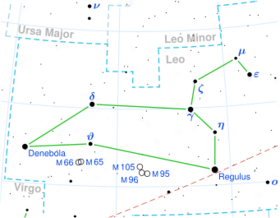Astronomy:Epsilon Leonis
| Observation data Equinox J2000.0]] (ICRS) | |
|---|---|
| Constellation | Leo |
| Right ascension | 09h 45m 51.07330s[1] |
| Declination | 23° 46′ 27.3208″[1] |
| Apparent magnitude (V) | 2.98[2] |
| Characteristics | |
| Spectral type | G1 II[3] |
| U−B color index | +0.47[2] |
| B−V color index | +0.808[4] |
| Variable type | suspected[5] |
| Astrometry | |
| Radial velocity (Rv) | 4.86 ± 0.33[4] km/s |
| Proper motion (μ) | RA: –45.61[1] mas/yr Dec.: –9.21[1] mas/yr |
| Parallax (π) | 13.22 ± 0.15[1] mas |
| Distance | 247 ± 3 ly (75.6 ± 0.9 pc) |
| Absolute magnitude (MV) | –1.49[6] |
| Details | |
| Mass | 4.01[6] M☉ |
| Radius | 21[4] R☉ |
| Luminosity | 288[4] L☉ |
| Surface gravity (log g) | 2.2[4] cgs |
| Temperature | 5,248[4] K |
| Metallicity [Fe/H] | –0.28[4] dex |
| Rotational velocity (v sin i) | 8.1[4] km/s |
| Age | 162[6] Myr |
| Other designations | |
| Database references | |
| SIMBAD | data |
Epsilon Leonis (ε Leo, ε Leonis) is the fifth-brightest star in the constellation Leo, consistent with its Bayer designation Epsilon. It is known as Algenubi or Ras Elased Australis. Both names mean "the southern star of the lion's head". Australis is Latin for "southern" and Genubi is Arabic for "south".
Properties
Epsilon Leonis has a stellar classification of G1 II, with the luminosity class of II indicating that, at an age of 162 million years,[6] it has evolved into a bright giant. It is much larger and brighter than the Sun with a luminosity 288 times and a radius 21 times solar.[4] Consequently, its absolute magnitude is actually –1.49,[6] making it one of the more luminous stars in the constellation, significantly more than Regulus. Its apparent brightness, though, is only 2.98.[2] Given its distance of about 247 light-years (76 parsecs), the star is more than three times the distance from the Sun than Regulus. At this distance, the visual magnitude of Epsilon Leonis is reduced by 0.03 as a result of extinction caused by intervening gas and dust.[6]
Epsilon Leonis exhibits the characteristics of a Cepheid-like variable, changing by an amplitude of 0.3 magnitude every few days.[8][7] It has around four times the mass of the Sun and a projected rotational velocity of 8.1 km s−1.[4] Based upon its iron abundance, the metallicity of this star's outer atmosphere is only around 52% of the Sun's. That is, the abundance of elements other than hydrogen and helium is about half that in the Sun.[4]
See also
References
- ↑ 1.0 1.1 1.2 1.3 1.4 van Leeuwen, Floor (November 2007), "Validation of the new Hipparcos reduction", Astronomy and Astrophysics 474 (2): 653–664, doi:10.1051/0004-6361:20078357, Bibcode: 2007A&A...474..653V Note: see VizieR catalogue I/311.
- ↑ 2.0 2.1 2.2 Johnson, H. L. et al. (1966), "UBVRIJKL photometry of the bright stars", Communications of the Lunar and Planetary Laboratory 4 (99): 99, Bibcode: 1966CoLPL...4...99J
- ↑ "eps Leo". SIMBAD. Centre de données astronomiques de Strasbourg. http://simbad.u-strasbg.fr/simbad/sim-basic?Ident=eps+Leo.
- ↑ 4.00 4.01 4.02 4.03 4.04 4.05 4.06 4.07 4.08 4.09 4.10 Massarotti, Alessandro et al. (January 2008), "Rotational and Radial Velocities for a Sample of 761 HIPPARCOS Giants and the Role of Binarity", The Astronomical Journal 135 (1): 209–231, doi:10.1088/0004-6256/135/1/209, Bibcode: 2008AJ....135..209M
- ↑ Samus, N. N. et al. (2009). "VizieR Online Data Catalog: General Catalogue of Variable Stars (Samus+ 2007-2013)". VizieR On-line Data Catalog: B/GCVS. Originally Published in: 2009yCat....102025S 1. Bibcode: 2009yCat....102025S.
- ↑ 6.0 6.1 6.2 6.3 6.4 6.5 Takeda, Yoichi; Sato, Bun'ei; Murata, Daisuke (August 2008), "Stellar parameters and elemental abundances of late-G giants", Publications of the Astronomical Society of Japan 60 (4): 781–802, doi:10.1093/pasj/60.4.781, Bibcode: 2008PASJ...60..781T
- ↑ 7.0 7.1 Kaler, James B., "ALGENUBI (Epsilon Leonis)", Stars (University of Illinois), http://stars.astro.illinois.edu/sow/algenubi.html, retrieved 2010-05-10
- ↑ Andrievsky, S. M. (July 1998), "BA II lines as luminosity indicators: s-Cepheids and non-variable supergiants", Astronomische Nachrichten 319 (4): 239–240, doi:10.1002/asna.2123190405, Bibcode: 1998AN....319..239A
 |


